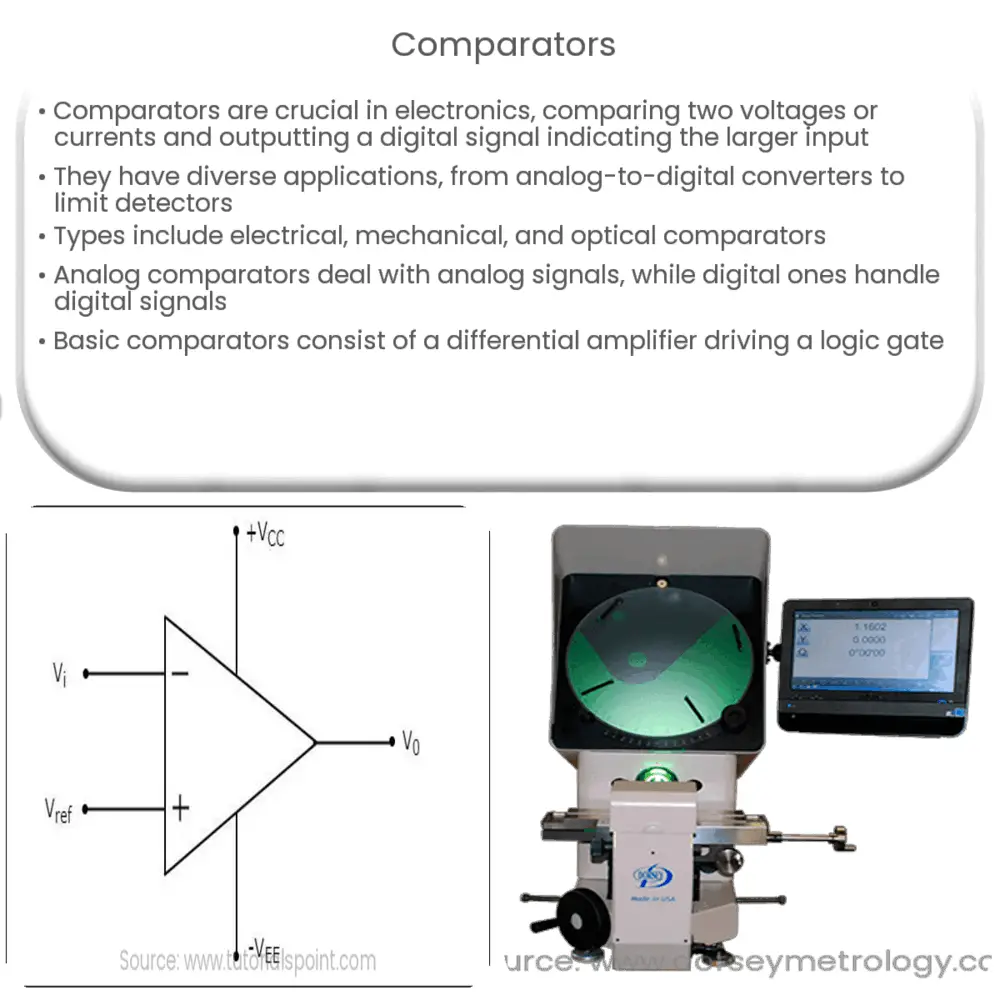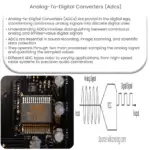Explore the world of comparators in electronics: their functionality, types, applications, common circuits, limitations, and importance.

Introduction to Comparators
A comparator is a significant component in the world of electronics and digital systems. By definition, a comparator is a device that compares two voltages or currents and outputs a digital signal indicating which of the two inputs is larger.
The Functionality of Comparators
Comparators are widely used in electronic devices for a variety of applications, such as analog-to-digital converters (ADCs), which convert analog signals into a digital format for processing by digital circuits. They are also used in electronic level and limit detectors, where they compare a continuously varying voltage or current with a preset level.
Types of Comparators
- Electrical comparators: These are primarily used in measurement and control systems.
- Mechanical comparators: These are typically used for comparing physical dimensions such as diameters, lengths, and thicknesses.
- Optical comparators: Often called shadowgraphs or profile projectors, these devices compare the silhouettes of manufactured parts with their ideal or nominal outlines.
Analog and Digital Comparators
In addition to the above types, comparators can also be classified into analog and digital comparators. An analog comparator compares the analog signals, while a digital comparator compares digital signals. Analog comparators output analog signals, while digital comparators output digital signals. The main difference between the two lies in the types of signals they accept and output.
Basic Operations of Comparators
A basic comparator consists of a differential amplifier that drives a logic gate. When the non-inverting input (V+) is higher than the inverting input (V–), the output of the comparator goes HIGH. Conversely, when the inverting input (V–) is higher than the non-inverting input (V+), the output goes LOW.
Comparator Characteristics
The speed, precision, power consumption, and cost are essential characteristics of comparators. The speed refers to how quickly the comparator can respond to changes in input, precision is the accuracy with which the comparator can measure the difference between two inputs, power consumption relates to the energy efficiency of the comparator, and cost is the overall expense involved in acquiring and implementing the comparator.
Applications of Comparators
Comparators are fundamental components in a wide variety of electronic applications. Here are some notable uses:
- Zero Crossing Detectors: A comparator with its one input connected to a reference voltage of zero can detect the zero crossings of an AC signal. This application is crucial in phase-locked loops and demodulation.
- Data Transmission: In digital data transmission systems, comparators are used for error detection and correction.
- Relay Switching: Comparators can trigger relays when certain threshold conditions are met, making them useful for building automated systems.
Common Comparator Circuits
Several popular comparator circuit designs are used in electronics, each suited to different applications:
- Open Loop Comparator: This is the simplest form of comparator which consists of a single operational amplifier without any feedback.
- Inverting Comparator: An inverting comparator is one in which the input voltage is applied to the inverting input terminal of the op-amp, and the non-inverting input is grounded.
- Non-inverting Comparator: Conversely, a non-inverting comparator is one where the input voltage is applied to the non-inverting input terminal, and the inverting input is grounded.
Limitations of Comparators
While comparators are incredibly useful devices, they do have some limitations. For example, they can suffer from instability issues, particularly in high-frequency applications. Additionally, comparators can be sensitive to noise on their inputs, which can lead to false triggering. To mitigate these issues, proper design and layout practices are crucial.
Conclusion
In conclusion, comparators are essential tools in electronics, playing pivotal roles in a wide array of applications. Whether it’s measuring physical dimensions or helping to convert analog signals into digital ones, the utility of comparators can’t be overstated. Understanding how comparators work, their types, characteristics, applications, and limitations is critical for anyone interested in electronics and digital systems. As technology continues to evolve, the roles and capabilities of comparators are likely to expand, making them even more vital components in the world of electronics.




